Are you wondering, “what is a sausage tree”? The hilariously named “sausage tree” is a comical-looking example of nature at its most playful.
But names can be deceiving. Indigenous to tropical Africa, the sausage tree’s proper name is Kigelia africana and is a bit of a rock star in the tree world.
Yes, it’s odd-looking, but that’s part of what makes it distinctive. It happens to have quite the reputation for being one of the most useful trees to human existence for literally thousands of years.
You can use most of the sausage tree in one way or another. Whether you’re eager to learn about its uses or wondering “what does sausage fruit taste like,” these fascinating facts will satisfy your curiosity.
Let’s take a closer look at this marvel of nature and see whether it carries its formidable weight.
Sausage Tree Facts
From Kigelia africana benefits to fruit edibility, here are some interesting facts about one of Africa’s finest examples of practical beauty.
Sausage trees have many names
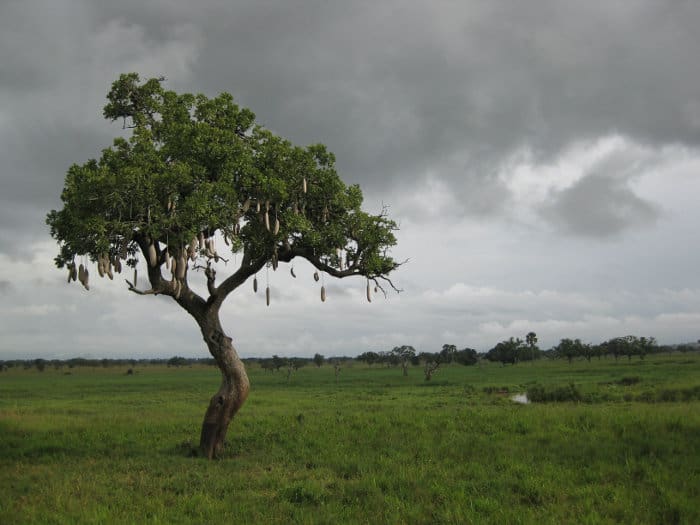
By now, you know that the sausage tree’s real name is Kigelia africana. It is also sometimes called Kigelia pinnata. But when traveling in Africa, you may hear several other local names. Here’s a quick reference:
- English: Sausage Tree, Cucumber Tree
- North Sotho: Modukguhlu
- Zulu: umVunguta, umFongothi
- Venda: Muvevha tree
- Tswana: Moporota tree
- Afrikaans: Worsboom
Where to find the Kigelia africana
Sausage trees mostly thrive in the wet African savanna and tropical regions of Sub-Saharan Africa. Interestingly, it also seems to have acclimatized in places like Hawaii, India, and Australia.
It is usually found along rivers or on floodplains, where it likes the flood-prone alluvial soil. It can do well in regions with all-year rainfall (where it stays evergreen) or even with specific rain seasons (as a deciduous plant).
The tree itself grows 60-70 feet tall (18-21 m), spreading its branches wide – it provides good shade on hot days.
The African sausage tree comes from a glamorous family
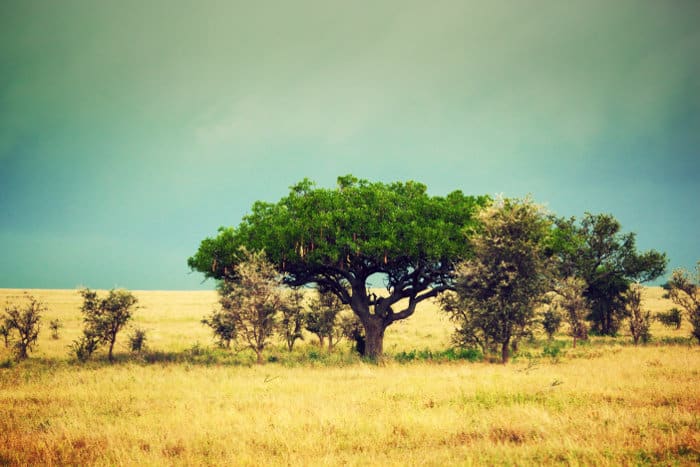
The Bignonia family contains some of the world’s most magnificent flowering trees. Many of Africa’s popular trees also belong to this family, like the Calabash, the Cape Honeysuckle, and the Jacaranda.
These are all known for their beauty or unusual looks. There are also many vines connected to the family.
The sausage plant gets its colloquial name from its fruit, which resembles – yes – a large sausage.
Tip: If you’re curious about plant life, check out these wild African plants – there might be a few that surprise you.
What is sausage fruit?
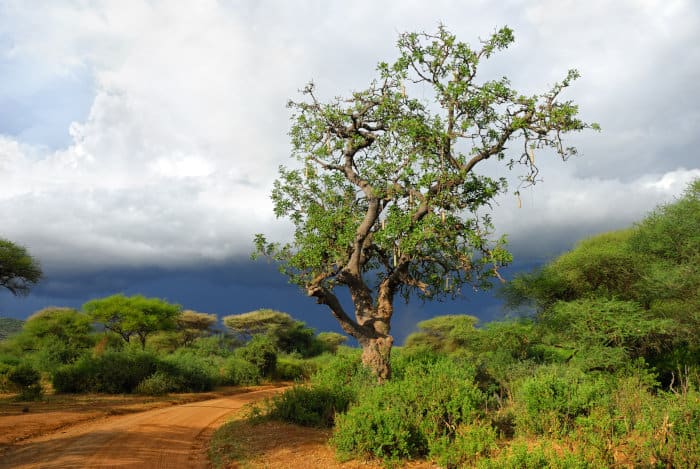
Sausage tree flowers are a distinctive and beautiful deep maroon or red color. They hang from long stems in clusters, usually below the main crown of the tree.
Their yellow pistils and stamen make for a bright spectacle against the red body. They mostly bloom at night and are velvety on the inside.
The flowers have a rather strong smell and tend to be unpleasant to humans. They do attract bats, birds, and insects, while facilitating pollination in the process.
Is sausage tree fruit edible?
The fruit can grow to a formidable size – up to three feet in length (0.91 m) – and weigh up to 30 lbs (13.6 kg). It is a woody berry containing seeds and a pulpy texture.
Can you eat sausage tree fruit? In its raw form, the sausage tree fruit is poisonous to humans, so don’t try to eat it!
Is sausage fruit edible for animals? Surprisingly, many animals don’t seem to have much of a problem.
The sausage tree fruit is edible to monkeys, baboons, elephants, birds, and other creatures that are particularly fond of the fibrous pulp.
These animals ultimately deposit the fruit seeds through their dung, which helps to spread the species.
Beware!
Falling fruit can be quite harmful if you’re underneath it. So avoid sitting directly below a sausage tree.
Sausage tree benefits & fruit uses
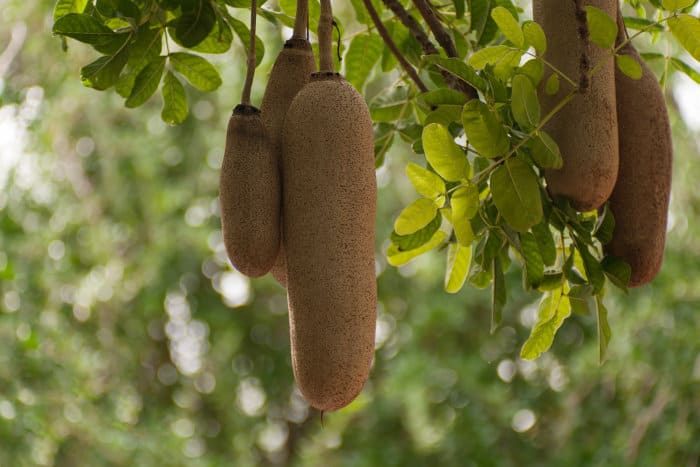
What does sausage tree fruit taste like? As mentioned, the fruit of the Kigelia is poisonous to humans if consumed raw, but it tastes quite good when prepared properly.
For instance, it’s a popular ingredient in traditional African beer. To reach edible status, the fruit is sun-dried and fermented twice for up to four days.
It’s also a common component in traditional medicine. And local tribes hang the fruit in their homes to protect them from extreme weather.
Kigelia leaves are edible as well – kudu and elephants seem to like them – and humans can ingest them when dried.
The leaves contain a high concentration of flavonoids, arguably known for their antidiarrhoeal properties.
The sausage tree wood is useful
While a hollowed-out fruit shell makes for a good container, the trunks of sausage trees have been particularly useful to natives for thousands of years.
Bear in mind that the tree trunks are a good size and robust. They make for excellent canoes when hollowed out, which is especially convenient knowing that Kigelia trees love riverine and wetland areas.
No tree is perfect though, not even the “Tree of Life”. Kigelia wood itself is too soft to be used in modern construction, but it is great as a crate and shelving material.
Local beliefs about the sausage tree – Africa
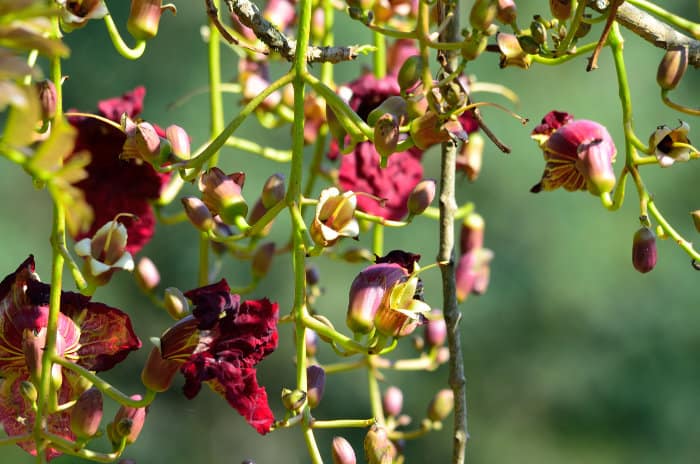
The tree has spiritual significance for some African tribes. According to local beliefs, the talismanic qualities of the tree can ward off evil spirits.
In the Ndebele culture, the tree plays a particular role in the death of a family member. Legend has it that when a loved one dies far from home, the Ndebele people will bury a sausage tree fruit in place of the body.
Sausage tree medicinal uses
Sausage tree fruit is a regular ingredient in many traditional medicines and can help treat multiple ailments. These include:
- Ulcers
- Gastrointestinal issues
- Malaria
- Rheumatism
- Spleen inflammation
- Syphilis (and other venereal diseases)
- Headaches
For the most part, the fruit is dry before use. However, there are some cases when people use the bark, roots, leaves, and stems for medicinal purposes.
In addition to internal medicine, the fruit can treat psoriasis, eczema, and other skin-related ailments. In the cosmetic world, you can find it in costly anti-aging and beauty creams.
It is truly an all-around useful species.
See the Sausage Tree on Safari
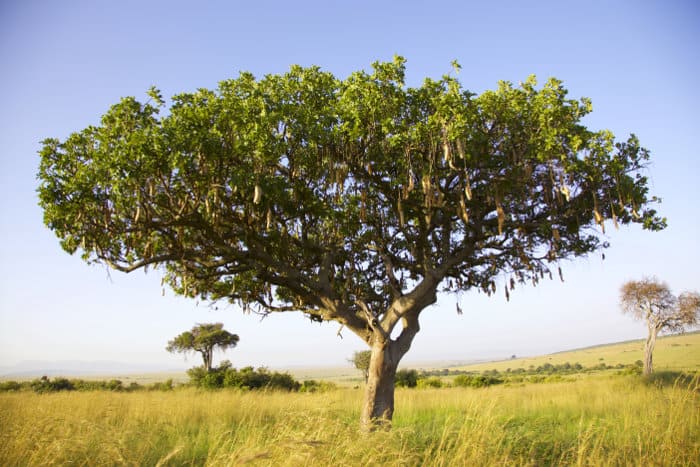
The sausage fruit tree has been around for thousands of years, feeding, protecting, and healing animals and people. It is a precious medicinal plant with tons of unexplored potential.
So the next time you go on an African safari, remember Kigelia africana, the ‘Tree of Life’ with amazing benefits. Be sure to take a moment to pay respects to the tree that does it all. Your ancestors will thank you!
For those still wondering, “are sausage trees real?” it might be time to book a trip to Africa – you may even spot an elephant nibbling on the leaves.
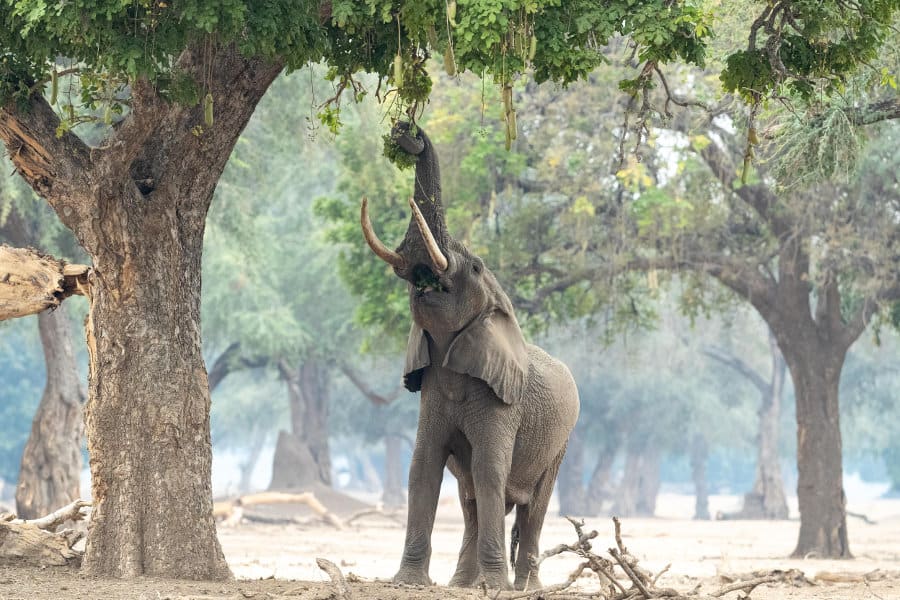
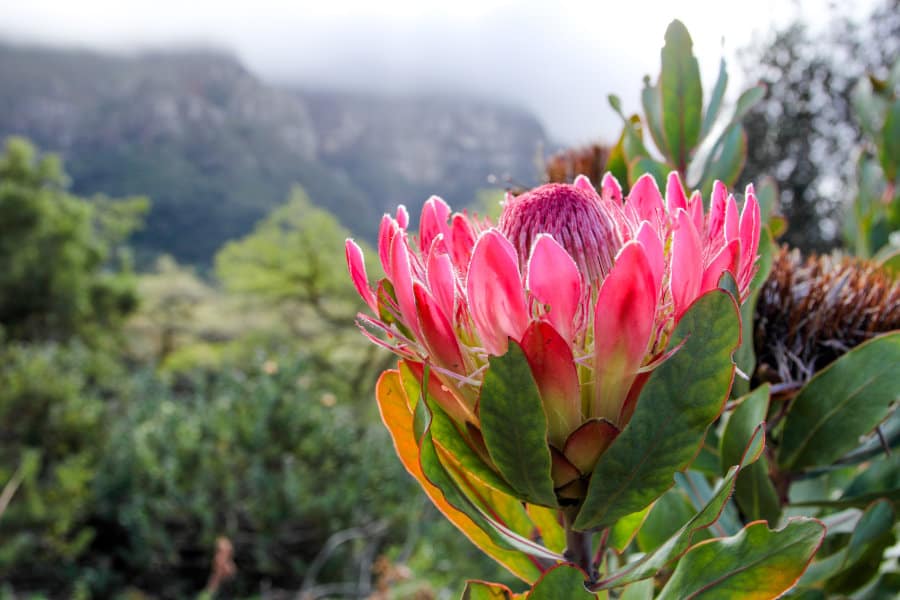
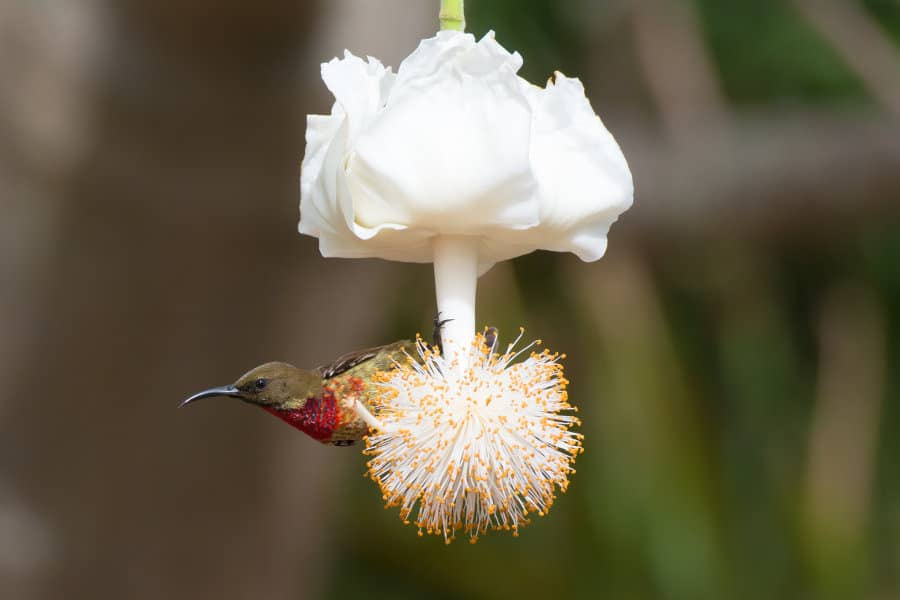
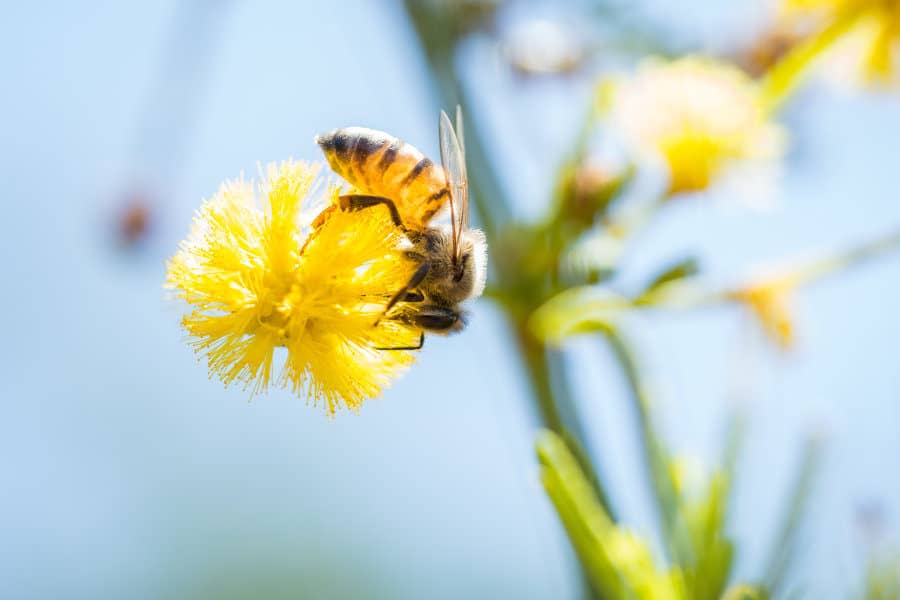
Thank you for the information about this tree. I have one in my backyard, I live in Fort Myers Florida (southwest Florida).
You are definitely right about being careful when the fruit drops from the tree.
I have actually heard one of the larger ones thud on the ground from inside my house
Seeds of Kigelia grow easily if one slices a section flat on the side of mature fruit.
The fibre will decay if placed in soil and kept moist for 12 months and seeds then grow from the moist rotted fibres inside the open side of the fruit.
This fibre soil will sustain the seedlings for 2 mths then plant out.
Interesting, thanks for sharing Noel.
Is it possible to make the anti-aging concoction at home?
Hi,
I don’t see why it wouldn’t be possible, though I don’t have the recipe.
Perhaps you can search for it online?
Best of luck,
Michaël
We live in north Queensland Australia and have one of these in our back yard. I have no idea how it got here, but we have always known that they originate in Africa and thought that rhinos like the fruit but I see it is actually elephants. Not many of them roaming around here. 🙂
Hi Paula,
How incredible, it would be interesting indeed to know how it ended up on your property. 🙂
While Australia doesn’t have any elephants, it is still home to amazing animals.
I’m sure I’d love your country.
Season’s greetings,
Michael
Can I boil the fruit and drink?
Hi Rebecca,
Please remember that the sausage tree fruit is inedible and poisonous to humans in its raw form.
As mentioned in the post there are instances where it can be consumed, though only when it is properly prepared and dried up.
Some people do indeed boil the dried fruit in water and drink the decoction. That being said, I would consult a specialist or seek professional medical advice before attempting anything on your own.
NB: You can actually buy dried Kigelia africana fruit or powder at local markets (and even online).
Hope this helps.
Good to learn